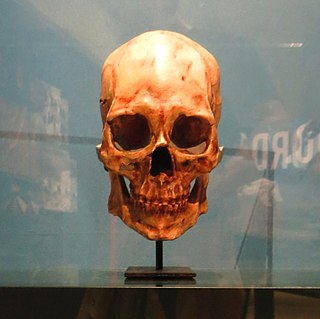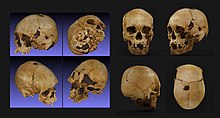
Kennewick Man or Ancient One was a Paleo-Indian whose skeletal remains were found washed out on a bank of the Columbia River in Kennewick, Washington, on July 28, 1996. Radiocarbon tests show the man lived about 8,900 to 9,000 years before present, making his skeleton one of the most complete ever found this old in the Americas, and thus of high scientific interest for understanding the peopling of the Americas.

Minas Gerais is one of the 27 federative units of Brazil, being the fourth largest state by area and the second largest in number of inhabitants with a population of 20,539,989 according to the 2022 census. Located in the Southeast Region of the country, it is limited to south and southwest with São Paulo; Mato Grosso do Sul to the west; Goiás and the Federal District to the northwest; Bahia to the north and northeast; Espírito Santo to the east; and Rio de Janeiro to the southeast. The state's capital and largest city, Belo Horizonte, is a major urban and finance center in Brazil, being the sixth most populous municipality in the country while its metropolitan area ranks as the third largest in Brazil with just over 5.8 million inhabitants, after those of São Paulo and Rio de Janeiro. Minas Gerais' territory is subdivided into 853 municipalities, the largest number among Brazilian states.

Peter Wilhelm Lund was a Danish Brazilian paleontologist, zoologist, and archeologist. He spent most of his life working and living in Brazil. He is considered the father of Brazilian paleontology as well as archaeology.

Australopithecus africanus is an extinct species of australopithecine which lived between about 3.3 and 2.1 million years ago in the Late Pliocene to Early Pleistocene of South Africa. The species has been recovered from Taung, Sterkfontein, Makapansgat, and Gladysvale. The first specimen, the Taung child, was described by anatomist Raymond Dart in 1924, and was the first early hominin found. However, its closer relations to humans than to other apes would not become widely accepted until the middle of the century because most had believed humans evolved outside of Africa. It is unclear how A. africanus relates to other hominins, being variously placed as ancestral to Homo and Paranthropus, to just Paranthropus, or to just P. robustus. The specimen "Little Foot" is the most completely preserved early hominin, with 90% of the skeleton intact, and the oldest South African australopith. However, it is controversially suggested that it and similar specimens be split off into "A. prometheus".

The National Museum of Brazil is the oldest scientific institution of Brazil. It is located in the city of Rio de Janeiro, where it is installed in the Paço de São Cristóvão, which is inside the Quinta da Boa Vista. The main building was originally the residence of the House of Braganza in colonial Brazil, as the Portuguese royal family between 1808 and 1821 and then as the Brazilian imperial family between 1822 and 1889. After the monarchy was deposed, it hosted the Republican Constituent Assembly from 1889 to 1891 before being assigned to the use of the museum in 1892. The building was listed as Brazilian National Heritage in 1938 and was largely destroyed by a fire in 2018.

The Altamura Man is a fossil of the genus Homo discovered in 1993 in a karst sinkhole in the Lamalunga Cave near the city of Altamura, Italy. Remarkably well preserved but covered in a thick layer of calcite taking the shape of cave popcorn the find was left in situ in order to avoid damage. Research during the following twenty years was based mainly on the documented on-site observations. Consequently, experts remained reluctant to agree on a conclusive age nor was there consensus on the species it belonged to.
Buhla is the name for a skeleton of a prehistoric (Paleo-Indian) woman found in a quarry near Buhl, Idaho, United States, in January 1989. The skeleton's age has been estimated by radiocarbon dating at 10,675 ± 95 BP, which confirms this as one of the oldest sets of human remains found in the Americas. The discovery was made by a quarry worker when he noticed what was found to be a thigh bone in the screen of a rock crusher. The nearly complete skeleton was subsequently unearthed nearby.

Lagoa Santa is a municipality and region in the state of Minas Gerais, Brazil. It is located 37 km north-northeast from Belo Horizonte and belongs to the mesoregion Metropolitana de Belo Horizonte and to the microregion of Belo Horizonte. In 2020 the estimated population was 65,657.

Walter Alves Neves is a Brazilian biologist, archeologist, anthropologist and a retired professor from the Department of Genetics and Evolutionary Biology of the Institute of Biosciences at the University of São Paulo. He was responsible for the study of Luzia, the oldest human skeleton on the American continent that was discovered by French archaeologist Laming-Emperaire during the 1970s, and the oldest rock inscription on the American continent, phallocentric.

Annette Laming-Emperaire was a French archeologist.

Juliomys anoblepas is a rodent in the genus Juliomys of the subfamily Sigmodontinae known from a single broken skull. The specimen was collected by Peter Wilhelm Lund in the caves of Lagoa Santa, Minas Gerais, Brazil, in the first half of the 19th century and described by Herluf Winge in 1888 as Calomys anoblepas. The species remained unstudied and its affinities unclear until 2011, when it was recognized as a member of the genus Juliomys, which includes three other species from southern Brazil and nearby Argentina and Paraguay. J. anoblepas is probably a separate extinct species of the genus, which is no longer found at Lagoa Santa.
Peñon woman or Peñon Woman III is the name for the human remains, specifically a skull, of a Paleo-Indian woman found by an ancient lake bed in Pueblo Peñón de los Baños in Mexico City in 1959.
Protopithecus is an extinct genus of large New World monkey that lived during the Pleistocene. Fossils have been found in the Toca da Boa Vista cave of Brazil, as well as other locales in the country. Fossils of another large, but less robust ateline monkey, Caipora, were also discovered in Toca da Boa Vista.
Naia is the name given to a 12,000 – to 13,000-year-old human skeleton of a teenage female who was found in the Yucatán Peninsula, Mexico. Her bones were part of a 2007 discovery of a cache of animal bones in an underwater chamber called Hoyo Negro in the Sistema Sac Actun. At the time of Naia's death, the cave system was mostly dry, and she likely died falling into Hoyo Negro.

The Sumidouro State Park is a state park in the state of Minas Gerais, Brazil. The remains of the first human inhabitants of Brazil were found in the park area in the early 19th century, along with bones of now-extinct megafauna. The main attraction is the Gruta da Lapinha, a large limestone cave.

The peopling of the Americas began when Paleolithic hunter-gatherers (Paleo-Indians) entered North America from the North Asian Mammoth steppe via the Beringia land bridge, which had formed between northeastern Siberia and western Alaska due to the lowering of sea level during the Last Glacial Maximum. These populations expanded south of the Laurentide Ice Sheet and spread rapidly southward, occupying both North and South America, by 12,000 to 14,000 years ago. The earliest populations in the Americas, before roughly 10,000 years ago, are known as Paleo-Indians. Indigenous peoples of the Americas have been linked to Siberian populations by linguistic factors, the distribution of blood types, and in genetic composition as reflected by molecular data, such as DNA.

The National Museum of Brazil was heavily damaged by a large fire which began about 19:30 local time on 2 September 2018. Although some items were saved, it is believed that 92.5% of its archive of 20 million items were destroyed in the fire as around 1.5 million items were stored in a separate building, which were not damaged.

Barras, Colin (2016-12-07). "Skull casket holding human bones reveals weird burial rituals". New Scientist. Archived from the original on 2016-12-08. Retrieved 2018-10-04.
Cláudia Rodrigues Ferreira de Carvalho, also Claudia Rodrigues-Carvalho, is a Brazilian archaeologist and is the director of the Science House of the Federal University of Rio de Janeiro (UFRJ) since 2018. She was the director of the UFRJ from 2010 to 2018. de Carvalho is also assistant professor of the Sector of Biological Anthropology of the Department of Anthropology of the National Museum.

The pre-Cabraline history of Brazil is the stage in Brazil's history before the arrival of Portuguese navigator Pedro Álvares Cabral in 1500, at a time when the region that is now Brazilian territory was occupied by thousands of indigenous peoples.




















